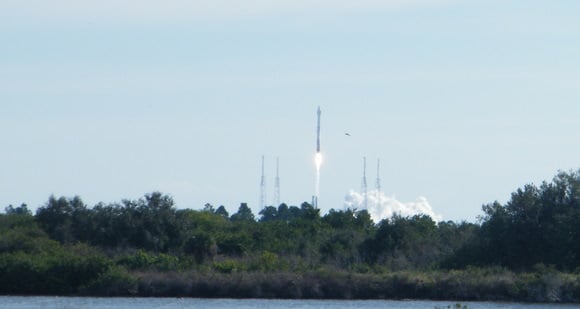The Solar Dynamics Observatory launched successfully – and beautifully – Thursday morning from Cape Canaveral Launch Complex 41 to begin a 5-year mission that will provide streaming, high-definition views of our sun. It was the 100th launch of the Atlas/Centaur combo, and was a gorgeous sight as it roared and soared into the blue Florida sky. "It was great; a beautiful launch," said Dean Pesnell, SDO Project Scientist, immediately after the launch. "The rocket rises so slowly off the pad -- it is wonderful to see. This is third Atlas launch I've seen and this is the best one so far."
Amazingly, viewers here at Kennedy Space Center saw the Atlas rocket fly close to a sundog just as the spacecraft reached Max-Q, creating a ripple effect around the spacecraft. "We saw this sundog come out and SDO flew right through it. Then the sun dog disappeared," said Pesnell. "This may be the first time we've sent a probe through a sundog, and people will be studying this, so already we are learning things about our atmosphere from SDO."
See this amazing video shot by a 13-year-old girl in attendance at the KSC VIP site that shows the sundog and shockwave.
(as noted by Jon Hanford in the comments).
Today's countdown was extremely smooth as the high winds that thwarted Wednesday's launch attempt calmed as the opening of the launch window approached. After counting down to the planned T-4 minute hold, launch managers proceeded directly to launch at the beginning of the window at 10:23 a.m. EST.
[caption id="attachment_55461" align="alignnone" width="580"]
Project Scientist Dean Pesnell describing the launch. Image: Nancy Atkinson[/caption]
"I was a little worried about the clouds coming in," said Tom Woods, Principal Investigator for the EVE instrument on SDO, the EUV Variability Experiment, which will be studying the extreme ultraviolet radiation of the Sun. "But we were very excited to see SDO launch today, as otherwise it would have been a 10-day delay until the next attempt. It was a wonderful launch!"
"It was so beautiful," said Lika Guhathakurta, SDO program scientist immediately following the launch as we walked together back to the press building. "I can still feel the rumbling in my stomach!"
[caption id="attachment_55455" align="alignnone" width="580"]
SDO science team celebrates after the launch: Dean Pesnell, Jennifer Rumburg, Chris St. Cyr, and Lika Guhathakurta. Image: Nancy Atkinson[/caption]
Called the "Crown Jewel" of NASA's fleet of solar observatories, SDO is a technologically advanced spacecraft that will take images of the sun every 0.75 seconds and daily send back about 1.5 terabytes of data to Earth -- the equivalent of downloading 380 full-length movies every day.
[caption id="attachment_55456" align="alignnone" width="580"]
SDO launch. Credit: Nancy Atkinson[/caption]
"We're going to be able to better understand the Sun as a star," said Guathakurta, "but SDO will also give us a comprehensive view of how it interacts with the Earth and everything else in the solar system.
The sun's dynamic processes affect everyone and everything on Earth. SDO will explore activity on the sun that can disable satellites, cause power grid failures, and disrupt GPS communications. SDO also will provide a better understanding of the role the sun plays in Earth's atmospheric chemistry and climate.
[caption id="attachment_55463" align="alignnone" width="580"]
Vapor trail from the Atlas rocket after the SDO launch. Image: Nancy Atkinson[/caption]
A contrail from the launch appeared only in the region of Earth's atmosphere where conditions were right for cloud formation. "There weren't any clouds there, but we provided the very fine particles so that a contrail cloud appeared," said Pesnell.
A later update confirmed that SDO separated from the Centaur and the spacecraft's solar arrays deployed on time and correctly, and are now generating power.
Here's the video of the launch from NASA TV:
 Universe Today
Universe Today
